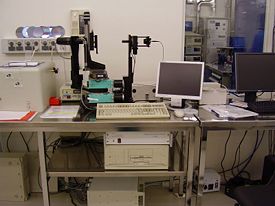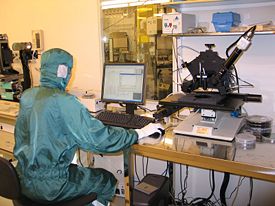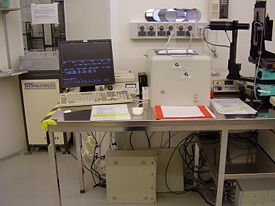Specific Process Knowledge/Characterization/Optical characterization: Difference between revisions
No edit summary |
No edit summary |
||
| Line 62: | Line 62: | ||
==Prism Coupler== | ==Prism Coupler== | ||
[[image:Prism_coupler.jpg|275x275px|right|thumb|Prism coupler: positioned in cleanroom 2]] | |||
<br clear="all" /> | |||
==Comparison of the three methods== | ==Comparison of the three methods== | ||
See here: [[Specific Process Knowledge/Characterization/Measurement of film thickness and optical constants#Film_thickness_and_optical_constants_of_optical_transparent_films|Film thickness and optical constants of optical transparent films]] | See here: [[Specific Process Knowledge/Characterization/Measurement of film thickness and optical constants#Film_thickness_and_optical_constants_of_optical_transparent_films|Film thickness and optical constants of optical transparent films]] | ||
Revision as of 14:00, 14 December 2007
Ellipsometer

Filmtek 4000

FilmTek 4000 is a computerized film thickness measurement and material characterization system. This system combines fiber-optic spectrophotometry with advanced material modeling software to provide an affordable and reliable tool for the simultaneous measurement of film thickness, index of refraction, and extinction coefficient
Normal incidence and polarized 70 degree reflection data is collected and used to calculate thickness and index of refraction of the measured film using SCI’s patented Differential Power Spectral Density (DPSD) technique. Absolute reflection data is obtained by comparing sample data to the measured reflection of a known reference sample, typically a silicon wafer with a thermally grown thin oxide (~63 nm) film.
The spectrophotometer scans the sample over a predefined range of wavelengths. The software generates a reflection spectrum based on a previously stored reference scan, and then performs a regression on the unknown parameters to fit the simulated reflection and power spectral density to the observed values. The resulting thin film parameters along with the measured and modeled spectra are then displayed for the user to examine.
A rough overview of the performance of the FilmTek
| Purpose | Film thickness measurements and optical characterization of optically transparent thin films |
|
|---|---|---|
| Performance | Thin film materials that can be measured |
Any film that is transparent to the light in the given wavelength range ex:
|
| . | Film thickness range |
|
| Process parameter range | Wavelength range |
|
| Substrates | Batch size |
|
| . | Substrate material allowed |
|
Prism Coupler

Comparison of the three methods
See here: Film thickness and optical constants of optical transparent films
